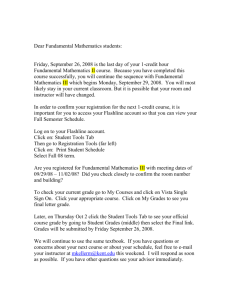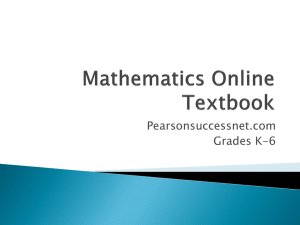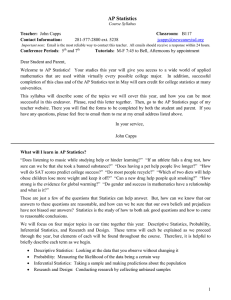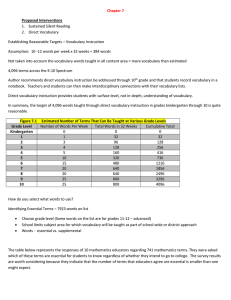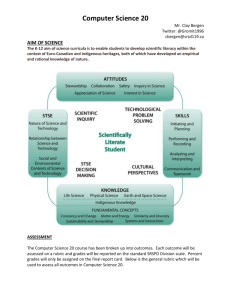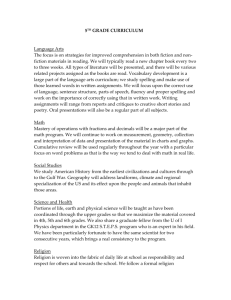Meet the Teacher
advertisement
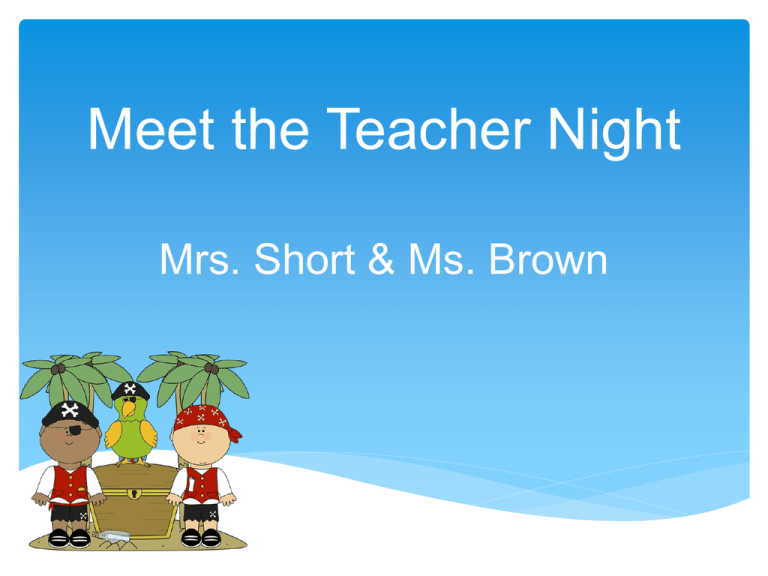
Meet the Teacher Night Mrs. Short & Ms. Brown Teacher Contact Information • Email or call to book an appointment • shortc@pearlandisd.org • brownm@pearlandisd.org • Phone Number 281-485-7912 • Conference times • 9:45-10:30 A.M. Class Schedule Mrs. Short’s Schedule 8:00-8:10 Announcements/Planner 8:10-9:40 Math 9:45-10:30 PE/Music/Library 10:35 Switch 10:35-11:50 Math 11:50-Restroom Break 11:54-12:24 Lunch (Brown’s) 12:24-12:39 Recess 12:40-1:05 Math 1:05-1:50 Science/Social Studies 1:50 Switch with Ms. Brown 1:55- 2:45 Science/Social Studies 2:45-3:00 Prepare for dismissal Computer lab- Mondays Art Lab- Fridays Ms. Brown’s Schedule 8:00-8:10 Announcements/Planner 8:10-9:40 Reading 9:45-10:30 PE/Music/Library 10:35 Switch 10:35-11:50 Reading 11:50-Restroom Break 11:57-12:27 Lunch (Short’s) 12:30-12:45 Recess 12:40-1:05 Reading 1:05-1:50 Writing/ Grammar 1:50 Switch with Mrs. Short 1:55- 2:45 Writing/ Grammar 2:45-3:00 Prepare for dismissal Classroom Rules Conduct and work habits are given a letter grade on your child’s report card. Each infraction your child receives will be noted daily in their conduct folder with an explanation why he or she was given the mark. Please take the time to discuss with your child why good behavior and work habits are important. Conduct Rules: 1.Follow directions 2.Follow directions outside of the classroom. 3.Raise your hand 4.Use appropriate language 5.Use an appropriate tone 6.Keep hands, feet, and objects to yourself 7.Remain in assigned location 8.Obey all drill procedures Work Habit Rules: 9. Turn in work/homework on time. 10. Be responsible for supplies. 11. Return materials to school. 12. Use time wisely. 13. Keep work space neat and organized. Homework Each student will bring home a homework folder on Mondays. It will contain your student’s homework for the week. Reading homework is a packet that is due on Friday. There is 20 minutes of reading a night, 2 spelling jobs, and cursive practice. When we get closer to STAAR the cursive will be replaced by reading passages. Spelling lists will be distributed on Mondays. There will be 2 spelling jobs that your child is required to complete as part of their homework. The jobs may change as new skills are taught, so please look at the bottom of the spelling lists. Spelling tests will be given on Fridays and will count towards 10% of the Language grade. Math homework is a packet that is due on Friday. The packet will contain only math. *Homework is an important part of 3rd grade. Please make sure your child is completing their homework weekly. Math Course Description Grade 3 Mathematics Course Description According to the Texas Essential Knowledge and Skills (TEKS): (1) Within a well-balanced mathematics curriculum, the primary focal points at Grade 3 are multiplying and dividing whole numbers, connecting fraction symbols to fractional quantities, and standardizing language and procedures in geometry and measurement. (2) Throughout mathematics in Grades 3-5, students build a foundation of basic understandings in number, operation, and quantitative reasoning; patterns, relationships, and algebraic thinking; geometry and spatial reasoning; measurement; and probability and statistics. Students use algorithms for addition, subtraction, multiplication, and division as generalizations connected to concrete experiences; and they concretely develop basic concepts of fractions and decimals. Students use appropriate language and organizational structures such as tables and charts to represent and communicate relationships, make predictions, and solve problems. Students select and use formal language to describe their reasoning as they identify, compare, and classify two- or three-dimensional geometric figures; and they use numbers, standard units, and measurement tools to describe and compare objects, make estimates, and solve application problems. Students organize data, choose an appropriate method to display the data, and interpret the data to make decisions and predictions and solve problems. (3) Throughout mathematics in Grades 3-5, students develop numerical fluency with conceptual understanding and computational accuracy. Students in Grades 3-5 use knowledge of the base-ten place value system to compose and decompose numbers in order to solve problems requiring precision, estimation, and reasonableness. By the end of Grade 5, students know basic addition, subtraction, multiplication, and division facts and are using them to work flexibly, efficiently, and accurately with numbers during addition, subtraction, multiplication, and division computation. (4) Problem solving, language and communication, connections within and outside mathematics, and formal and informal reasoning underlie all content areas in mathematics. Throughout mathematics in Grades 3-5, students use these processes together with technology and other mathematical tools such as manipulative materials to develop conceptual understanding and solve meaningful problems as they do mathematics. Reading/ELA Course Description Third Grade Reading Course Overview The English Language Arts & Reading Texas Essential Knowledge and Skills (TEKS) are organized into the following strands: Reading, where students read and understand a wide variety of literary and informational texts; Writing, where students compose a variety of written texts with a clear controlling idea, coherent organization, and sufficient detail; Research, where students are expected to know how to locate a range of relevant sources and evaluate, synthesize, and present ideas and information; Listening and Speaking, where students listen and respond to the ideas of others while contributing their own ideas in conversations and in groups; and Oral and Written Conventions, where students learn how to use the oral and written conventions of the English language in speaking and writing. The standards are cumulative--students will continue to address earlier standards as needed while they attend to standards for their grade. In third grade, students will engage in activities that build on their prior knowledge and skills in order to strengthen their reading, writing, and oral language skills. Students should read and write on a daily basis. Science Course Description 3rd Grade Science Course Description (1) Science, as defined by the National Academy of Sciences, is the "use of evidence to construct testable explanations and predictions of natural phenomena, as well as the knowledge generated through this process." (2) Recurring themes are pervasive in sciences, mathematics, and technology. These ideas transcend disciplinary boundaries and include patterns, cycles, systems, models, and change and constancy. (3) The study of elementary science includes planning and safely implementing classroom and outdoor investigations using scientific methods, analyzing information, making informed decisions, and using tools to collect and record information while addressing the content and vocabulary in physical, earth, and life sciences. Districts are encouraged to facilitate classroom and outdoor investigations for at least 60% of instructional time. (4) In Grade 3, students learn that the study of science uses appropriate tools and safe practices in planning and implementing investigations, asking and answering questions, collecting data by observing and measuring, and by using models to support scientific inquiry about the natural world. (A) Students recognize that patterns, relationships, and cycles exist in matter. Students will investigate the physical properties of matter and will learn that changes occur. They explore mixtures and investigate light, sound, and heat/thermal energy in everyday life. Students manipulate objects by pushing and pulling to demonstrate changes in motion and position. (B) Students investigate how the surface of Earth changes and provides resources that humans use. As students explore objects in the sky, they describe how relationships affect patterns and cycles on Earth. Students will construct models to demonstrate Sun, Earth, and Moon system relationships and will describe the Sun's role in the water cycle. (C) Students explore patterns, systems, and cycles within environments by investigating characteristics of organisms, life cycles, and interactions among all components of the natural environment. Students examine how the environment plays a key role in survival. Students know that when changes in the environment occur organisms may thrive, become ill, or perish. Social Studies Course Description §113.1. Implementation of Texas Essential Knowledge and Skills for Social Studies, Elementary. §113.5. Social Studies, Grade 3. In Grade 3, students learn how individuals have changed their communities and world. Students study the effects inspiring heroes have had on communities, past and present. Students learn about the lives of heroic men and women who made important choices, overcame obstacles, sacrificed for the betterment of others, and embarked on journeys that resulted in new ideas, new inventions, and new communities. Students expand their knowledge through the identification and study of people who made a difference, influenced public policy and decision making, and participated in resolving issues that are important to all people. Throughout Grade 3, students develop an understanding of the economic, cultural, and scientific contributions made by individuals. To support the teaching of the essential knowledge and skills, the use of a variety of rich material such as biographies; folktales, myths, and legends; and poetry, songs, and artworks is encouraged. Selections may include the legend of Paul Bunyan. Motivating resources are also available from museums, historical sites, presidential libraries, and local and state preservation societies. Third Grade Grading Policy 3rd and 4th = Numeric grades for reading, LA, Math, Science and SS (A, B, C, D, and F) following the district grading scale. Non numeric grades (S = 74.5-100, N= 69.5- 74.49 and U= 0-69.49) for music, PE, handwriting, health and art. Conduct and work habits = non numeric grades using (E = 89.5-100, S = 79.5- 89.49, N= 74.5-79.49, U = 0-74.49) Types of grades = daily (CR activities, quizzes, in-class writing samples) and major (long term projects and tests) Minimum number of grades = no one assignment should count more than 20% of the student’s grade. A minimum of two grades per week (combinations of daily and major). Science and Social studies, one grade per week (combination of daily and major) Study Hall We will provide study hall every day during recess time. If your child is not completing their work, they will go to study hall until they have completed all their assignments (this includes homework). Also, if they need to correct failing grades the teacher will re-teach the skill and they will have one opportunity to pull the grade up to a maximum score of 70%. They may also be assigned study hall to complete work they missed when they were absent. It is not a punishment, but an opportunity to get caught up and avoid zeroes in the grade book. Promotion Requirements In grades 3–6, promotion to the next grade level shall be based on an overall average of 70 on a scale of 100 based upon course-level, grade-level standards (essential knowledge and skills) for the following subject areas: mathematics, reading, language arts, science, and social studies. In addition, students must have a grade of 70 or above in each of the following areas: mathematics, reading, and language arts. STAAR Third graders are required to take the Reading and Math STAAR tests in April. More information will be shared throughout the year as the state releases it. Check out the state website regularly to see what information the state has released: TEA-3rd Grade STAAR Released Questions Resources for parents and students: Parent/Student Resources Other Important News Snack: Students are allowed to bring a quick, healthy snack to eat. Please do not send sugary foods like cookies, candy, etc. Please remember that it needs to be something that the child can eat while continuing to work on his/her assignments. Jackets: Your child is encouraged to bring a light jacket since some rooms are chilly. Please write your child’s name in the jacket and remind your child it is their responsibility to keep up with it. Chapter Book Study: We will be doing a study of 1 chapter book as a class this year. We are asking parents to purchase your child a copy of the book, Charlotte’s Web.
